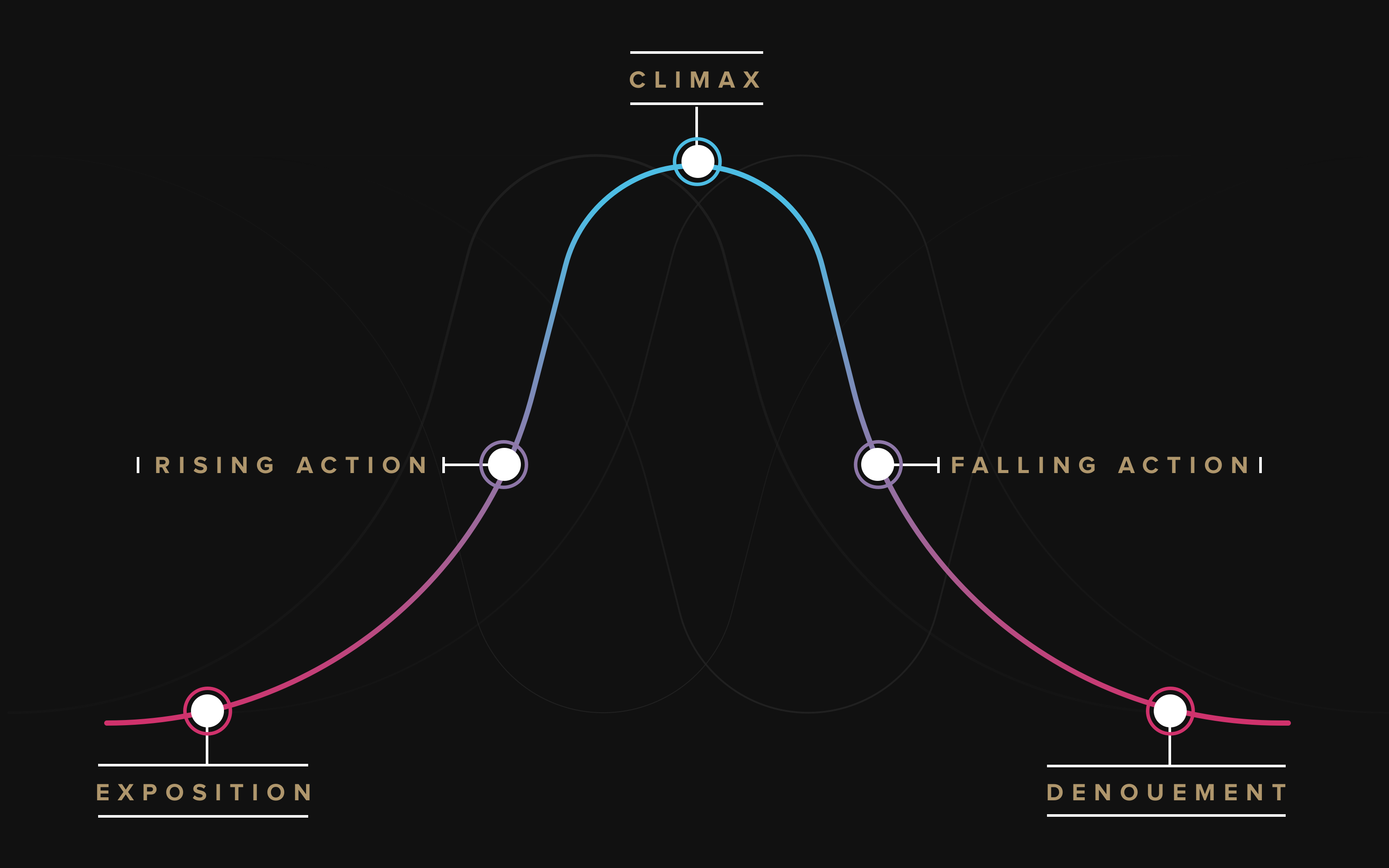Many millennia ago, in a place far, far away from Denver…
...a group of scruffy, wide-nosed and large-browed humans huddled around a crackling fire within a cool, dark cave.

In those simpler times, there was no incessant hum of machines bumbling down city streets, no sirens wailing ominously in the smoggy distance, no swarms of garment-clad professionals, entranced by small, sleek, metal objects illuminating their grim faces as they shuffle silently along gum-speckled sidewalks.
There was only food, water, shelter, fire, and of course, human interaction.
With written language long after their time, they exchanged something else while crowding around the source of warmth: verbal language, and more importantly, stories.
Though the original story cannot be traced back to a specific time and place, these ancestors of ours were already using them as a means of communicating experiences, life lessons, and more.
They were the first - but certainly not the last - to leverage the power of a story.
Think about your everyday life: how much of the information you take in, the ads that you see, the decisions you make, and everything else, is influenced by stories?
The answer is likely a lot, because marketers, business people, your friends, and scientists alike have one thing in common: they understand that storytelling is a very powerful and effective tool.
But...why and how is it so powerful?
Glance back at the beginning of this article, and imagine if, instead of painting the picture of our ancestors exchanging stories in simpler times, I told you:
Stories have been around since the beginning of mankind.
Would it have the same effect?
I’d wager not, and the reasons for that are within this post.
Without further ado, this article will cover…
Let us begin with the big question…
Why Do Humans Love Stories?
.gif)
Don't worry, there's more to it than the GIF above claims. In fact...
There are three main reasons as to why storytelling is such a powerful means of communicating, convincing, and connecting.
First, as a species...
We Are Social Beings

Storytelling is one of the primary means by which humans communicate with other people.
As social beings, we need interaction with other humans, and stories allow us to keep tabs on what is happening in our social circles, communities, and more.
By this reasoning, humans are reacting to more than just the story; they’re reacting to the need for human interaction, too.
Storytelling is a lasting means of communication that holds universal appeal.
Just consider how it’s constant across cultures, continents, and communities - from ancient Egypt and Sumer all the way to modern-day Siberia and Quebec.
The more social and innovative our species is, the more globalized we become, which creates a need to learn the customs and rules of society - both at home for newborns and abroad for tourists and expats.
Stories are the most digestible means of learning new information, especially when it has to do with introducing a person to the societal norms of modern-day humans all over the world.
Perhaps the most important element of the social nature of humans is the urge to share with other humans: when you have a great story, do you keep it to yourself, or share with anyone who will listen?
(I’m going to bet that most readers would declare the latter.)
This is one of the many reasons why storytelling is so effective in the professional realm, as marketers can hope to spread a contagious or compelling story with their audience to better capture their attention and, hopefully, loyalty.
When a consumer sees a really compelling story in an ad, they will be more likely to tell their friends by word of mouth, which perpetuates the effectiveness of the ad’s message.
Understanding Our Existence

Stories give meaning to our lives.
As Cody C. Delistraty puts it...
Stories are a form of existential problem-solving.
Cody c. delistraty
Storytelling is a way to make sense of our world around us that, and it was used even before humans could competently articulate their feelings, thoughts, and knowledge.
It’s also a good rough measuring tool for history: the primary way that humans order their experience in time is through narrativity.
That’s because we’re a storytelling species that live storied lives, both individually and in social settings.
Because of our affinity for them, we know a narrative when we feel it - it engages us through psychological realism, or through recognizable emotions and conceivable interactions between characters.
What is the result of this effect?
The familiarity of stories helps capture the audience’s attention, which is why metaphors are so darn effective - and popular.
When learning about something for the first time, you may find yourself likening it to something familiar, typically by saying something along the lines of, “oh! This is like…” and finding common ground between the known and the unknown.
Consider, then, the effectiveness of using a story to convince prospects of how your brand fits into and improves their lives.
Everyone has problems, big or small.
By providing your target market with a narrative that portrays the effectiveness of your brand’s ability to problem-solve for them, you’re demonstrating the importance of the prospects’ need to find a solution and relaying the positive cause and effect relationship that your brand delivers.
Finally, and maybe most importantly, stories can serve as a…
Learning Tool

Storytelling is part of our creative side, and it is within us all.
We all have the capacity to learn in creative ways, and storytelling is one of those.
This realization is gaining increasingly more ground, leading to reimagined learning opportunities both in a school setting and commercial alike.
Would you rather read a list of facts about an unfamiliar brand or hear their inspirational story for why they started their business? The first scenario contains only data, and the second also captures emotions through a narrative.
Storytelling is part of our creative side, and it is within us all. #contentmarketing #storytelling
When it comes to engaging students or converting prospects into loyal customers, relaying data and emotions together is much more effective than data alone.
In fact, Stanford Graduate School of Business professor of marketing Jennifer Aaker says that people remember information when presented in a narrative about 22 times more than if presented with just the facts alone.
This means that the most efficient means of getting pupils’ full attention when teaching a new concept is through storytelling, and the same goes for teaching non-customers about your brand.
Teaching anyone about anything - students, marketing enthusiasts, etc. - is more effective with storytelling because it’s almost like providing them with a consequence-free practice round.
By providing the safe and imaginary world of a story, the learner gains a training ground to use before the real-world trial of their knowledge or skills.
Many times, industry-specific bloggers will teach readers about a new concept or application to their life by walking the readers through their own experience: the learning curve, the before-and-after comparison, the most important elements, and even the mistakes they made - so that their readers don’t have to go through the same struggles.
Now that we know why stories are so effective, let’s dig a little deeper.
The Psychological Effects of Storytelling

This is where things get a little interesting, because as it turns out, our brains are hardwired to respond emotionally to good storytelling.
First of all, stories motivate and persuade us by appealing to our human emotions: when we hear a good story, our brain synthesizes oxytocin, which is responsible for empathy and narrative transport (immersion in a story).
This synthesis makes our brains more sensitive to social cues as well as more trustworthy, compassionate, and generous, which is why charities craft emotionally powerful stories to rack up donations.
Let me paint the picture with an example.
Scenario A:
Laurie is a 5-year-old girl who was diagnosed with leukemia a few years ago. She only has so long to live, so her family is raising money for her to have a comfortable rest of her life.
Scenario B:
Laurie’s mother has been standing by her 5-year-old daughter’s side for her years-long battle against leukemia, and she is constantly facing the reality that her beloved young daughter doesn’t have very long to live. Even so, Laurie’s mother strives every day to put aside her grief, hide it from her dying daughter, in order to give her the chance to enjoy her final days on earth and suffer a little less along the way. In light of this, Laurie’s mother is raising money in order to help Laurie take her mind off of her shortening days by giving her the means to fulfill everything on her bucket list before it’s too late.
Which story would open your heart and sway you to donate to Laurie’s cause?
The reason scenario A isn’t as effective is because it’s just facts: though data activates the language processing parts of our brain, it does not activate anything else, and so it’s easy to tune out when information is presented in this manner.
On the flipside, brain scans of people listening to good stories light up like the neighborhood’s twinkly decorations during the festive season.
Add a story to your data, and the parts of the brain that are used when experiencing events will come to life: the visualization of motion activates the motor cortex, an appeal to the senses, such as flavor, activates the sensory cortex, and so on, which means that the brain is more active and engaged when information is relayed in a story.
As an example, think about how many commercials you have seen for restaurants where they walk you through an eloquent, detailed, step-by-step story of how their steak turns out so darn tasty.
If it made your mouth water, then the brand succeeded, because watery mouths need to be satiated, and what’s on the consumer’s mind?
That brand’s sizzling steak - their most likely next purchase.
At the very least, the consumer will first think of this brand when contemplating where to get a good steak in the future.
What I’ve found to be the absolute coolest perk of storytelling is that the storyteller’s brain can actually sync up with its listeners!
This essentially gives the storyteller the superpower of planting ideas, thoughts, and emotions in the audience’s brain, and even the ability to transfer her experience.
Imagine the convincing power that the storyteller holds: their excitement about a brand could be transferred to the audience, and their opinion can be manipulated, too.
That’s why the best marketing campaigns effectively convince consumers to do what they want; they have tapped into the power of telepathically persuading their audience of the value of their brand.
Finally, psychologically, humans can’t help but relate everything to their existing experiences; it’s how we learn and make sense of our world.
We’re always looking for the cause and effect relationship of everything, which is why we respond so well to metaphors.
Remember how we touched on the fact that synthesized oxytocin makes us more compassionate?
Our need for relation causes stories to active insula while our brains search for a similar experience. This helps us relate to the same experience of joy, disgust, pain, and more when hearing a story - and the reason we become so engaged, too.
That’s why, many-a-time, bloggers will introduce a tutorial or educational topic with, “have you ever been so lost/frustrated/hopeless/dissatisfied/etc. with this subject that you didn’t know what to do?”
Or something along those lines.
The point is, these writers know to start with a classic storytelling tactic of triggering your sympathy of the same frustration - when you connect emotionally and attention-wise, they succeed.
Speaking of success…
What Makes a Story Effective?
A story is a powerful persuasive tool when executed well.
There are basic elements to every good story, such as the dramatic arc that every tale ever follows religiously, or that it develops a narrative, which is simply a written account of a series of related events.

The best stories, especially the ones passed down through generations and spread through cultures, go beyond just painting a picture that’s believable and organized.
They succeed in captivating the audience; the listeners’ emotions become woven together with the characters’ emotions.
This engrossment is dubbed a state of “narrative transport” by psychologists, where the listener is mentally transported from real life to the imaginary world of the story.
To achieve this, stories must capture attention by growing the tension of the story.
Once the audience’s attention is sustained, they begin to emotionally resonate with the characters, which triggers their instincts.
Then, the psychological stuff happens, and the audience is properly hooked in every way.
There are seven main ways in which a story can captivate the audience’s attention:
1. Automaticity
The startling sensory details that engage the audience, such as the firing of a gun, are automatic reactions in our brains. These sensory cues trigger our instincts and successfully capture our attention.
TIP:
Try to include strong sensory details in the next story you write, whether it’s in a blog article or in ad copy, to yield higher engagement rates - and ideally, conversion rates, too.
2. Framing
You could either adapt to your audience’s interests and “frame” or change them to leverage triggering their emotional engagement. One way to convince your audience of something is to repeat the message until it sinks in. In the 70’s, a classic study found that exposing subjects to the same statement repeatedly eventually led to the subjects believing it is true.
TIP:
Identify your target audience’s interests and use them as a reference point for the angle of your writing. It’ll not only prove that your brand knows exactly who it’s selling to, but it will also keep the audience engaged by relating it to something the readers already find interesting.
Leverage what your audience already cares about when telling a story.
3. Disruption
Shake up the audience’s life a little - the more disruptive something is, the more interesting it becomes. Why else do you think the buzzword “disruptive” works so well to create excitement about a new innovation? Of course, your story needs to be disruptive or surprising in a positive way, but be sure to pay special attention to anything that violates our expectations in a huge or dramatic way to really hook ‘em.
TIP:
If your brand is innovative in its industry, that’s the big headline: show your audience how their life will be forever changed by your brand - in a good way, of course.
Otherwise, your brand could craft a story that takes an extraordinary angle on an ordinary topic, which is sure to turn heads.
4. Reward
The prospect of capturing our desires, whether they’re food, sex, money, or otherwise, makes us pay attention. This aligns with the effect of anticipation and motivation, for the audience will be more inclined to tune into a story that helps them achieve their goals. I’m not saying that humans are selfish, but rather that we are intrinsically driven by rewards.
TIP:
Rewards that we can touch, visualize, or experience in any other way have greater impact than ones that are just communicated in minimal terms. The more real the gold at the end of the rainbow seems from your story, the more the audience will react positively to it by listening.
5. Reputation
Who you are and what you’ve accomplished really matters, so if you’re trying to capture the attention of an audience that doesn’t know you, start off with your credentials, your expertise, and if that isn’t effective, reference known experts on the topic. That way, subconsciously, your audience will trust everything you have to say on the matter. It turns out that the decision-making centers of our brains shut down when we receive advice from an expert - we take it all in as tried and true.
TIP:
Establish your expertise on a topic to make your story more engaging; the audience will care to hear what you have to say when you prove to them that you know your stuff.
If you’re not yet an expert, that’s okay too - use credible references instead.
6. Mystery
Psychologically, humans dislike uncertainty and will do everything in their power to reduce it in any way possible; we have a compulsion for completion. It just so happens that our mind is fine-tuned to remember incomplete stories and tasks. Did you ever have an unresolved scenario in your life nag at you endlessly, disrupting your focus in other areas?
Personally, I watched 6 seasons, or 121 episodes, or nearly 91 hours of the show Lost just to resolve all of the questions I had from watching episode one. Now that I know how it ends, I’m partially satisfied and partially wishing I used those 91 hours of my life in a more productive way - but, in the end, the show succeeded in sucking me in with the element of mystery.
TIP:
Create an air of mystery in your story to capture the curiosity of your audience. Don’t give everything away immediately; rather, let them in on enough juicy details to get them hooked, then let it linger to grab their full attention.
When it comes to content marketing, writing articles in which you assign your readers tasks will drive their compulsion to complete it, making your writing more actionable and engaging in that way.
7. Acknowledgement
Because humans have a deeply-rooted and vital need for validation and empathy from others, we strive, as a species, to find where we belong and are appreciated. Everyone is constantly searching for their community that cares, and so a story can captivate the audience’s attention by catering to this need.
TIP:
Acknowledge where your audience is coming from and that you care about their success through your writing. Capture the essence of this in a story by showing your prospects, through the power of words, that they’re not alone and that you’re there to help.
Comfort and appreciation can go a long way in storytelling.
The Bottom Line

Storytelling is the best way to captivate your audience and convert prospects into loyal customers.
Everyone loves a good story.
After reading this article, you are better equipped to go forth and become the storyteller that engages the right people at the right time.
I’ll leave you with a quote from Steve Rubel, the Chief Content Strategist at Edelman:
“Attention is the most important currency that anybody can give you.”
Steve Rubel
So go, tell great stories in all areas of your marketing, and reap the benefits of getting quality attention from quality leads!




